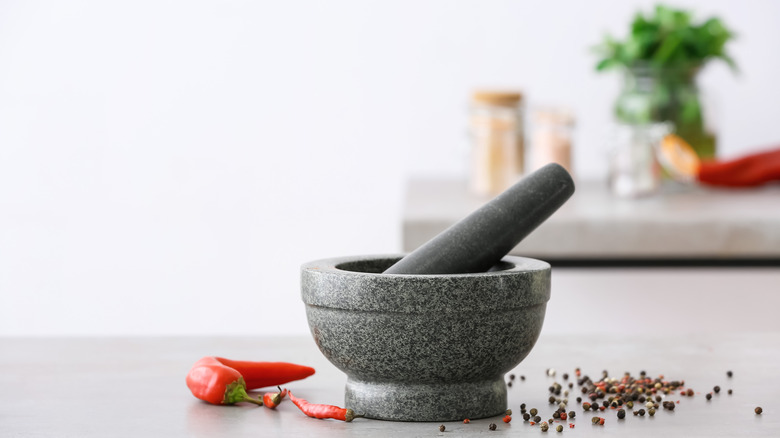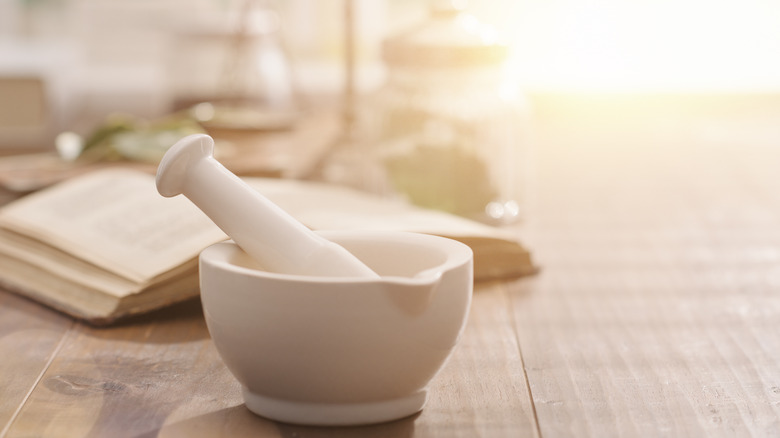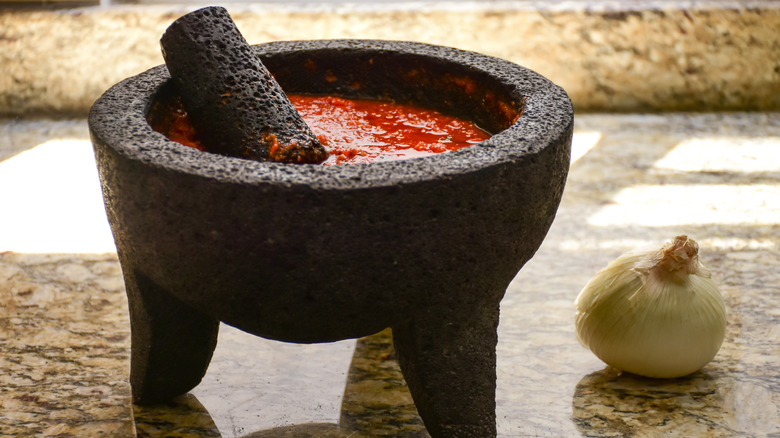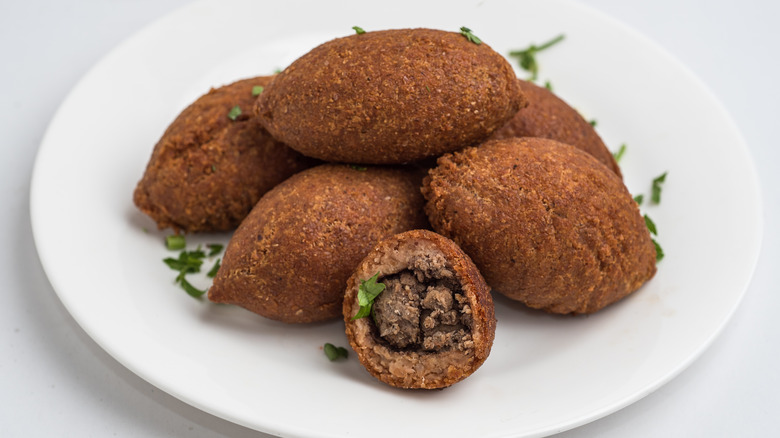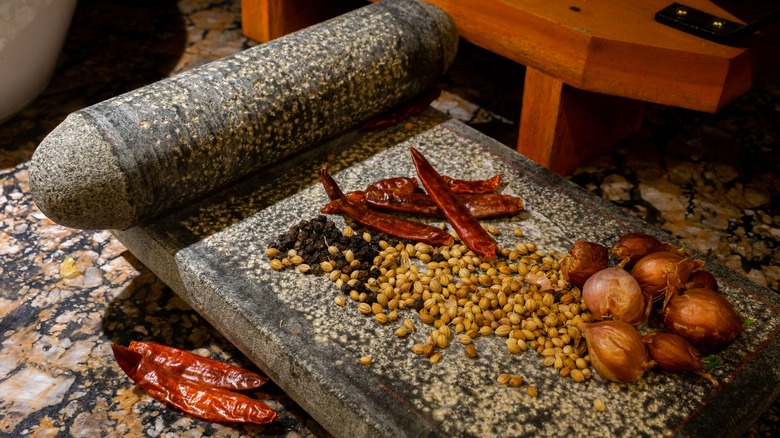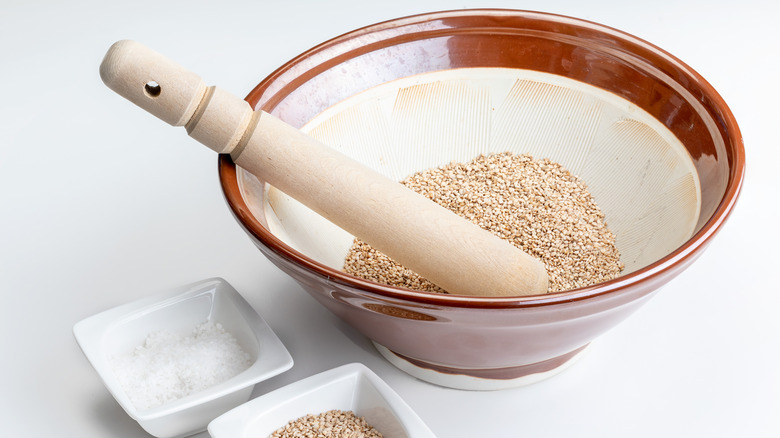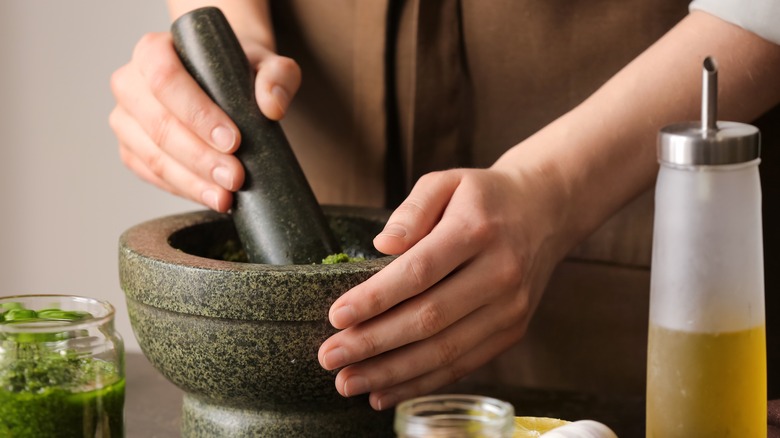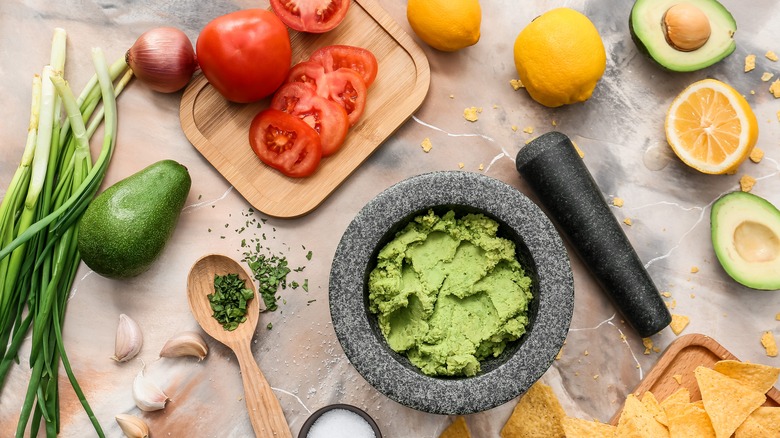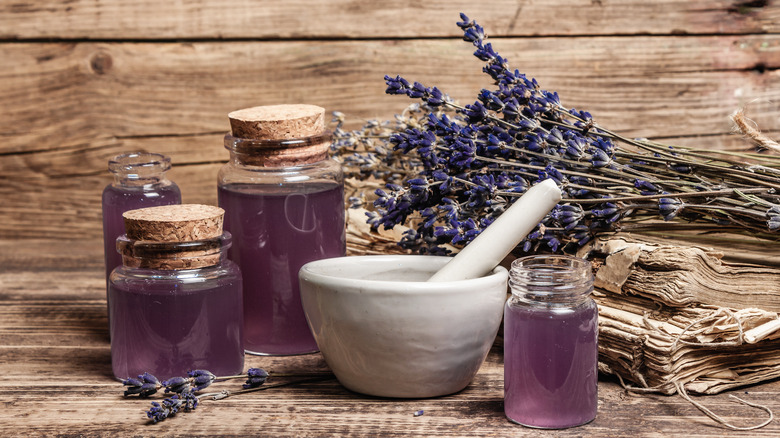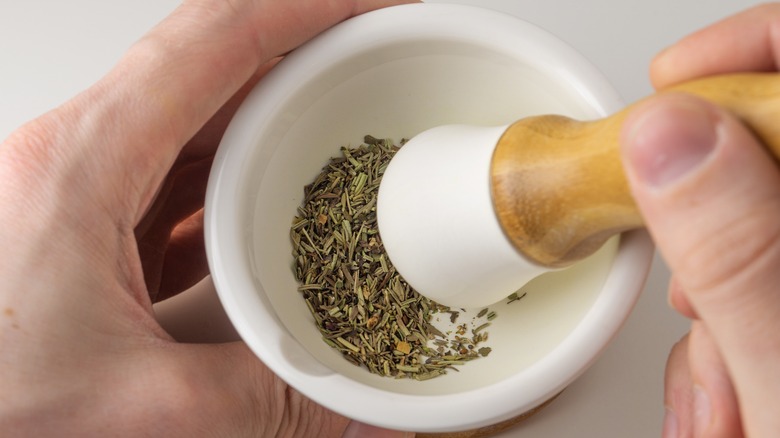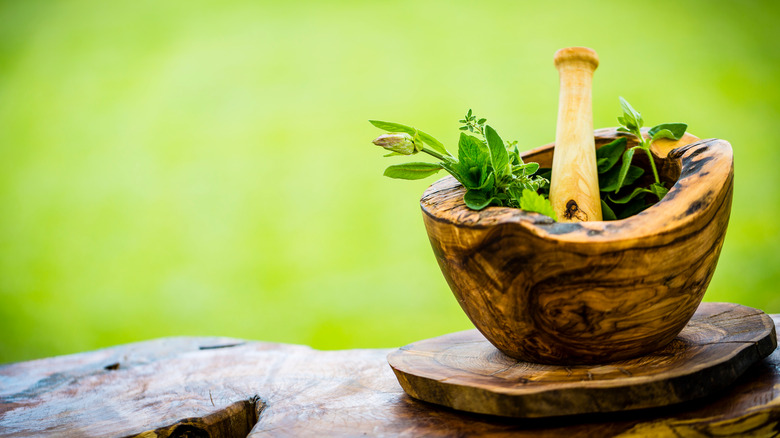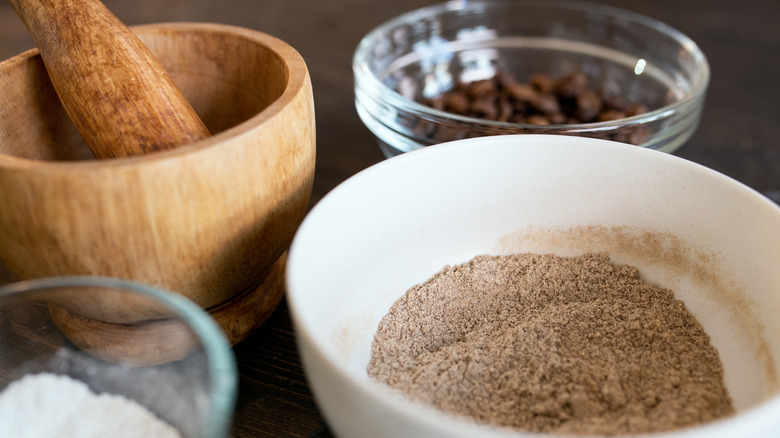Everything You Need To Know About The Mortar And Pestle
Nowadays, the mortar and pestle is known as an extremely useful, lo-fi kitchen tool. Originally, though, it was first widely used as pharmaceutical equipment, according to Smithsonian, and was fabricated in various sizes out of a range of materials, including bronze, glass, wood, stone, and more. Mortar means "bowl for pounding" and pestle is defined as a "club-shaped instrument used for pounding and breaking materials," per the Online Etymology Dictionary. Both words can trace their roots back to Latin.
The mortar and pestle still exists in a vast range of shapes, sizes, and forms. A quick Google search will bring up just about everything, from your standard granite and marble mortar and pestles meant for cooking to a high-end designer version crafted by Italian fashion designer Brunello Cucinelli. Clearly, the utensil that has made its mark on mankind since the dawn of human civilization has continued to prove its worth and is not going out of style anytime soon.
The mortar and pestle in antiquity
According to SpiceTrekkers, archaeologists have discovered variations of the mortar and pestle dating back 35,000 years ago. Pounding foodstuff in stone, it seems, is a primal instinct that led to the creation of this ancient tool. Its use predates even the advent of agriculture.
Given the honor of being a "rare example of stable technology" by The Atlantic, variations of the mortar and pestle have been found all over the globe and have been used for a variety of purposes. The mortar and pestle has been used by ancient civilizations like the Greeks, Romans, Aztecs, native American Sioux, Indo-European Celts, and Egyptians, who wrote about the tool in the Egyptian Ebers Papyrus, the oldest preserved medical text on earth. The mortar and pestle also appears in 14th-century Italian fresco paintings and illustrations, and the Roman poet Juvenal wrote glowingly about its medical and pharmaceutical utility.
Mortar and pestle used in medicine
Making medicine necessitates a lot of mixing and grinding. Naturally, the mortar and pestle has long been an indispensable tool in pharmacies and apothecaries for druggists and chemists. The National Pharmacy Museum even hosts a large collection of mortar and pestles, most donated by pharmacists.
The Atlantic's deep dive into the history of the mortar and pestle reports small porcelain sets were used by chemists and pharmacists to deploy trituration — the act of reducing the size of the particles of a substance — for making medicine. The University of the Sciences in Philadelphia paid homage to the tool with a dedicated exhibition in 2005 and may have the largest collection in the world. Even today, some scientists today still use the tool to reduce chemicals into powder. Popular drugstore chain Walgreen's even employed the mortar and pestle as its logo in 1951, per Money Inc.
The Mexican molcajete
If you've ever dined at a Mexican restaurant and ordered fresh table-side guacamole, the guac was made in was likely a molcajete, the Spanish word for a mortar and pestle. The molcajete is usually made out of volcanic stone. The tool is common in Mexican households and is traditionally passed down from one generation to the next, per UTSA's Institute of Texan Cultures.
According to Mexican Food Journal, the molcajete can be seen as a "Prehispanic blender or food processor" and is better for releasing the essential oils of certain ingredients to add depth of flavor to a dish. This makes molcajetes optimal for blending salsas. You can easily find an authentic one on Amazon as a unique addition to your kitchen arsenal. Just like mortar and pestles need to be seasoned, molcajete should also be cured before use. YouTuber Rachel Cooks With Love provides a helpful tutorial.
Grinding meat in the Middle East
Modern meat processing usually involves a meat grinder, unless you decide to mince your meat by hand. In the Middle East, however, a meat filling called kibbeh is made by pounding and grinding together lamb, onions, and bulgur wheat, per the Los Angeles Times. Other countries substitute different grains for the bulgur, like rice in Iraq.
Predictably, that kind of meat processing requires size and weight. According to Taste of Beirut, the mortar and pestle used for kibbeh is called a jeren, and could weigh a solid 100 pounds. It's a massive mortar carved out of a stone that's several feet high with a matching pestle about the size of a baseball bat. The jeren requires plenty of muscle to break down the meat into a texture "smooth as silk" and is superior to a modern food processor because the jeren's manipulator can manually remove any ligaments or arteries in the meat.
The Indian Sil Batta
Indian cuisine is famous for its use of spices. It calls for numerous condiments and curries, and even uses a method called tarka to infuse more depth of flavor into certain recipes. Before modern technology, most Indian households had a cooking tool made up of two flat stones. It's referred to as the Sil Batta in the north of India, but has other names in the south (Ammi) and east (Sila Puaa), according to a report by The News Agency.
This mortar and pestle variant is flatter, as the user moves the batta (the smaller stone) back and forth on the sil (the bigger stone). Common uses included grinding up spices, lentils, and rice to create the flour for dosa batter, as well as making chutneys. The stone rubbing creates heat, which mixes with the spices' natural oils and makes their flavors even more pronounced and powerful. If you're interested in Indian cooking the traditional way, you can find a Sil Batta on Amazon.
Suribachi, the Japanese mortar and pestle
While many cultures' mortars and pestles are made up of the local materials at hand, the Japanese take on the culinary tool, the suribachi and surikogi, is carefully comprised of a variety of materials. The suribachi, or grinding bowl, is usually a ceramic bowl that is glazed on the outside and unglazed on the interior surface, per A Certain Aesthetic. The interior is also intentionally ridged to create a texture to better break down the ingredients. The surikogi (the pestle) is made of wood, which helps the suribachi maintain its texture.
Chinese traders first brought the mortar and pestle to Japan in the 11th century, and eventually, the Japanese adapted the tool to their cuisine. The suribachi and surikogi was commonly used to make miso, dressing, fish ball paste, grated Tororo, shredded fish flakes, and dumplings. According to Eater, the suribachi is the most optimized version of the mortar and pestle because the built-in grooves take on a lot of the grinding work.
The benefits of a mortar and pestle
Even if you don't regularly make guacamole, Indian food, or specialized Japanese miso paste at home, there are several other handy reasons to justify having a mortar and pestle stored in your kitchen. According to food writer and chef Jonah Reider, opting to grind your spices fresh makes dishes far more flavorful than using pre-ground ones. Using a mortar and pestle to break up garlic also keeps your hands clean and free of the garlicky smell.
Another dinner party hack involves using a mortar and pestle for delicious dips and dressings for your guests, both as the tool to make it and as a serving bowl. Anything for one less dish to clean up, right? A nice mortar and pestle will shine amongst a well-considered table setting. The act of hand-grinding also allows you to really see how your ingredients break down, and the hands-on process will never fail to impress guests.
Classic recipes to try with a mortar and pestle
When you're ready to move beyond simply grinding black pepper, there are plenty of easy recipes to bring your mortar and pestle game to the next level. Homemade guacamole is always a treat because it's easier on the wallet and you can customize it to your personal preferences with ingredients like jalapeno or cilantro. If you're more in the mood for Thai than Mexican, grab some ginger, garlic, galangal, palm sugar, cumin, coriander, kaffir lime leaves, lemongrass, and Thai chili green peppers to whip up Dirt Candy chef Amanda Cohen's Thai green curry.
A little too specific for you? If you want to make a more universal sauce-slash-condiment-slash-spread, try this easy sofrito recipe that can be paired with fish, chicken, burritos, chips, or just about anything. Store leftovers in the fridge for a quick and easy flavor boost that goes with every meal.
The best mortar and pestles on the market
If you're still looking for reasons to invest in a mortar and pestle, here are a few more: The kitchen tool doesn't require any electricity, there's a very little chance of breakage, and it can endure for generations to come. There are many types on the market, depending on your needs and budget. If you're looking to simply grind up spices, this wooden mortar and pestle is affordable and won't take up too much valuable counter space.
For clumsy cooks or those with kids, this porcelain mortar and pestle comes with a silicone base and is also dishwasher-friendly for easy clean-up. For an authentic Mexican molcajete, this one nearly has 1,000 five-star ratings. Miso lovers who want to try their hand at making their own should invest in this Japan-made suribachi and surikogi set made by Minoware. Finally, for an all-purpose mortar and pestle, this model by Priority Chef is sturdy, reliable, easy to use, and easy to clean.
Tips for spice grinding with your mortar and pestle
For those who have never used a mortar and pestle before, it's important not to add too much of the ingredient you'd like to break down. Famed chef Jamie Oliver demonstrates what not to do with a mortar and pestle in this YouTube video; essentially, you want to avoid overfilling the mortar and then whacking at the ingredients with the pestle, unless you want to create a mess of peppercorns everywhere.
To properly use a mortar and pestle for grinding spices, Oliver advises adding just a little bit to create just one layer of spices. Then begin with gentle tapping rather than big thumps, working your way around until most of the pieces have broken down into small enough pieces. Once you have pieces that are small enough for grinding, you can then take the pestle and grind it along the sides until your desired level of coarseness is reached.
Seasoning your mortar and pestle
If you are purchasing yourself a brand-new mortar and pestle instead of inheriting one, do not skip the important step of seasoning your new culinary tool before use. The process of curing or seasoning a mortar and pestle is easy and takes less than 10 minutes, and will prevent splintered pieces of wood or rock from getting into your food.
The first step is to clean your mortar and pestle with warm water only — avoid soap, as the suds can nestle their way into more porous mortar and pestles. Once rinsed, add a bit of white rice with a tablespoon of water to your mortar, and then grind until you see grit coming off of the insides and onto the rice. Rinse and repeat until nary a grit can be found on a grain and the resulting white paste is free of any impurities or color.
Mortar and pestle hacks and substitutes
The usefulness of a mortar and pestle applies to the beverage world as well, especially for caffeine fiends. If you find yourself with a bag of coffee beans and without a coffee grinder, a mortar and pestle is a great stand-in, according to Coffee Bean. A medium grind is best for pour over coffee, but for moka pots or espresso machines, a fine grind is preferred. Either way, using a mortar and pestle gives you the maximum amount of control over the coarseness of your coffee grinds.
If you find yourself mid-recipe which calls for a mortar and pestle and you haven't invested in one yet, there are some workarounds. To smash something up in a pinch, per Archute, you can try a rolling pin, wine bottle, meat hammer, or even a heavy-bottomed pan, and a ziplock bag. Of course, we'd recommend just investing in a mortar and pestle.
